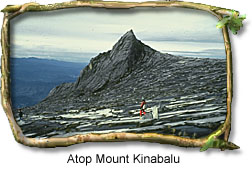|
One hundred and thirty eight kilometers from Kota Kinabalu, the capital of the Malaysian state of Sabah, rises the majestic Mount Kinabalu. With its peak at 4,101 meters (and growing), Mount Kinabalu is the highest mountain in South-East Asia. This distinction has earned it considerable attention in myth and legend as well as in geography, and the mountain has for most of history been revered as a sacred spot. The hundreds of square kilometers encompassed by its slopes, from sea level to the jagged stone edge marking its summit, form the Kinabalu National Park. Within this area is found some of the richest flora in the world, ranging from lowland dipterocarp forest to the montane oak, rhododendron, and conifer forests of the middle altitudes and eventually to the alpine meadows and stunted, windswept bushes of the summit.
The climb up Kinabalu is one reason why many visitors come. Despite its intimidating size, Kinabalu is one of the easiest mountains in the world to climb. No special skills or equipment are needed, and each year thousands of visitors undertake the expedition, which takes two to three days. Accommodation is available all along the climb, the highest lodging being the Sayat Hut at 12,500 feet. Those with high blood pressure or heart problems should not make the climb because of the high altitude involved. Though the Kinabalu Park is famous largely for the climb, the climb is in turn as famous for the beauty of its route as for the view from the top. Kinabalu's slopes possess a wealth of plant growth and a large variety of birds, and much of the climb's interest and beauty lies in tracing the transitions from one ecosystem to the next as one reaches ever higher altitude. For visitors with more time to spend in Kinabalu, there are graded paths leading through rich lowland forest to mountain rivers, waterfalls, and tumbled bat caves. The Poring Hot Springs, located nearby, are another prime attraction. The springs were developed first by the Japanese during W.W.II. Today the springs are piped into several open air, Japanese-style baths. The hot springs contain sulfur water, which has curative properties for skin diseases. For further information, please contact: Sabah
Parks
|
THE PARK AT A GLANCE: Size: 4,343
sq. km
The prime attraction here is the Hot Springs, first developed by the Japanese during World War II and now piped into several open-air Japanese style baths. For visitors with more time there are graded paths leading through rich lowland forest to mountain rivers, waterfalls and the tumbled bat caves.
|
|
||||
|
Home | Places | People | History | Nature
|
||||||
